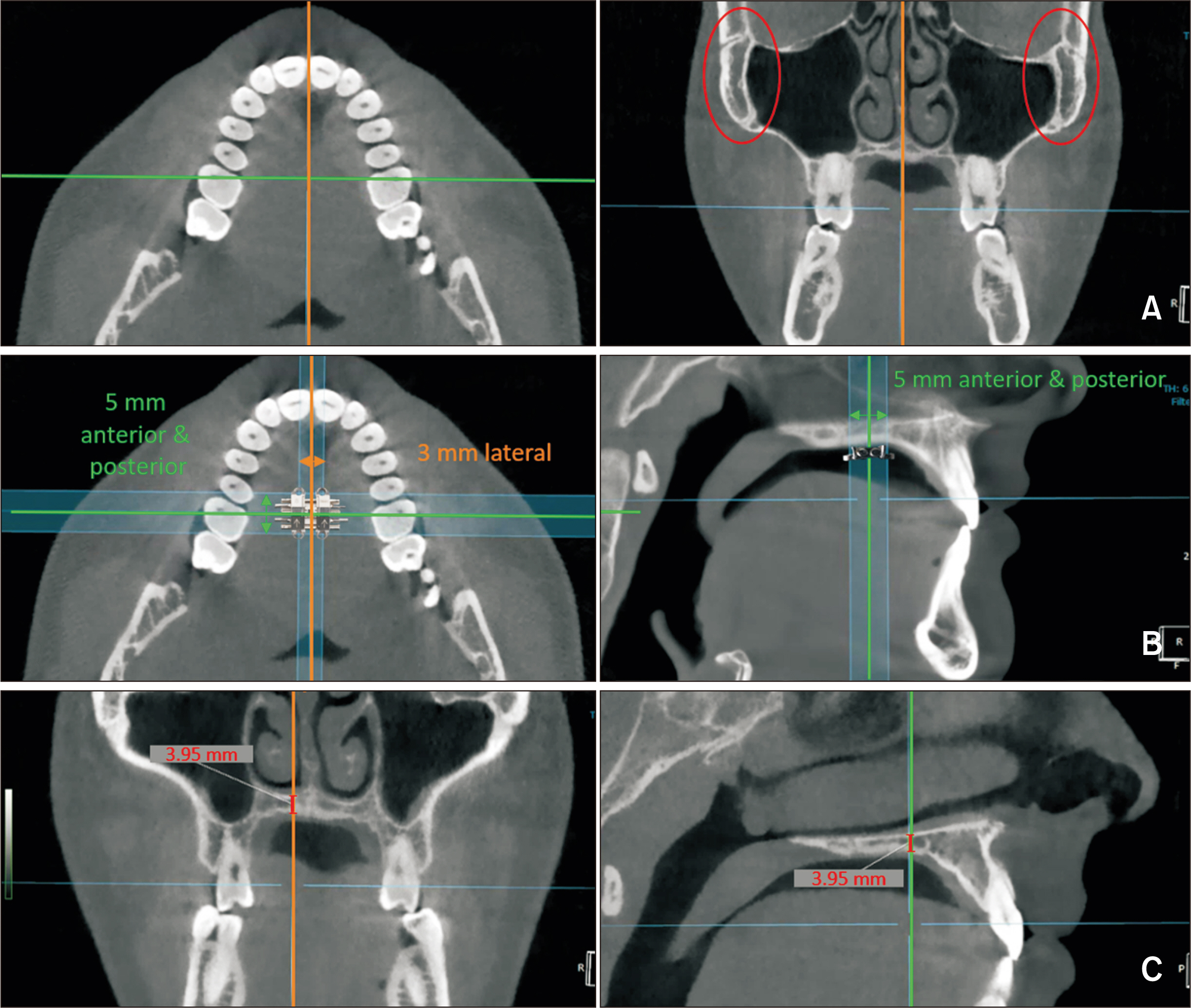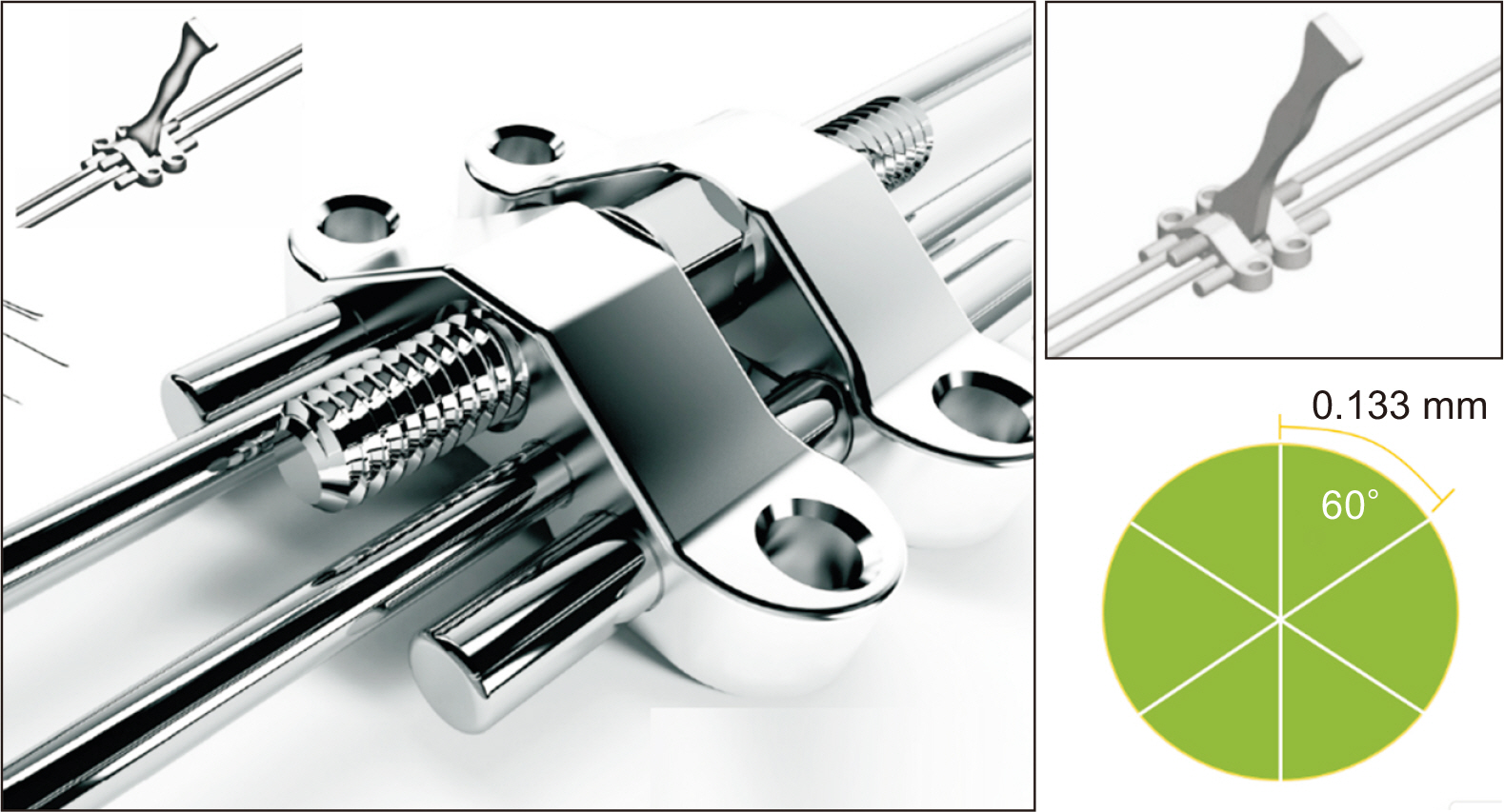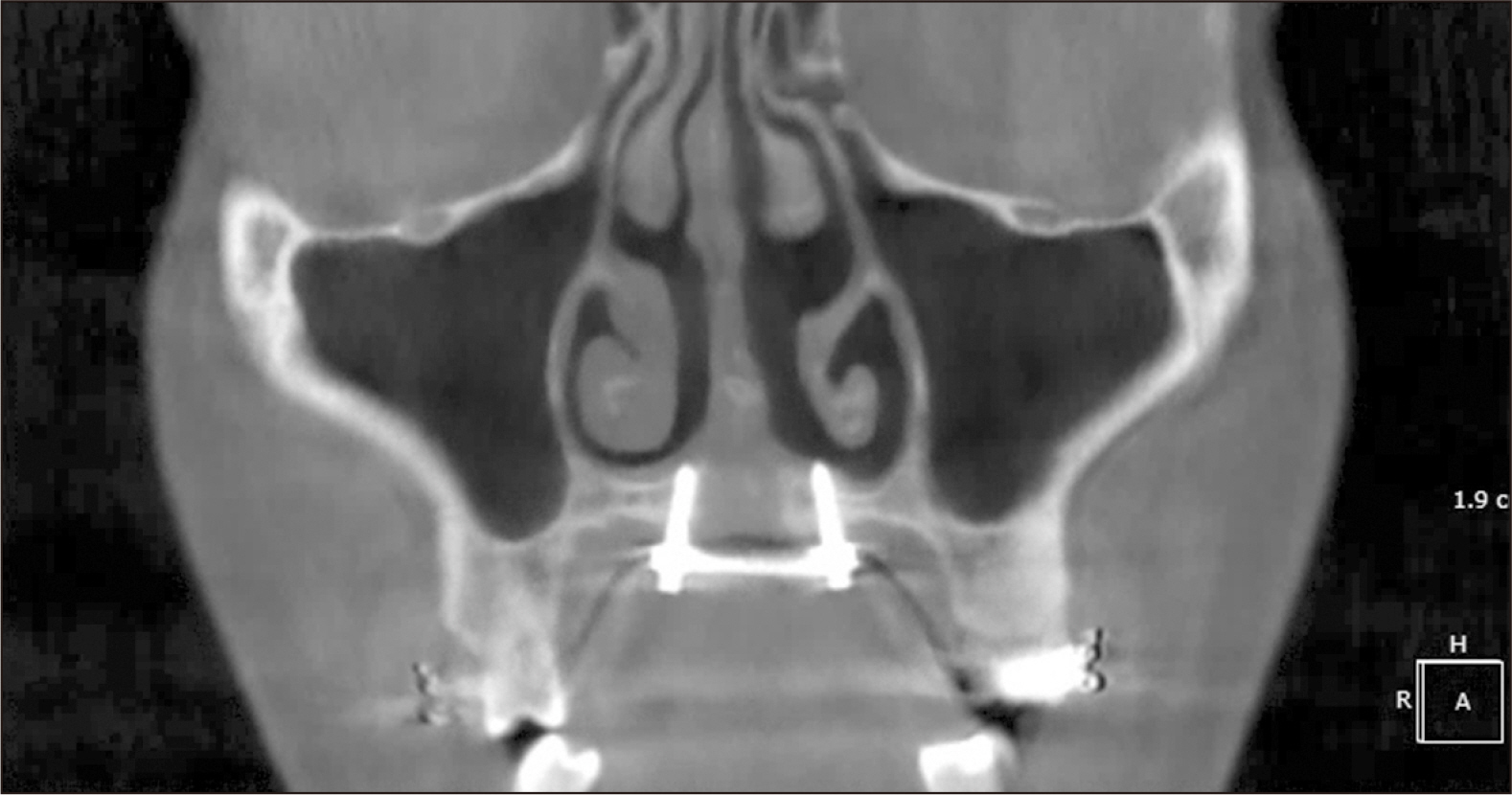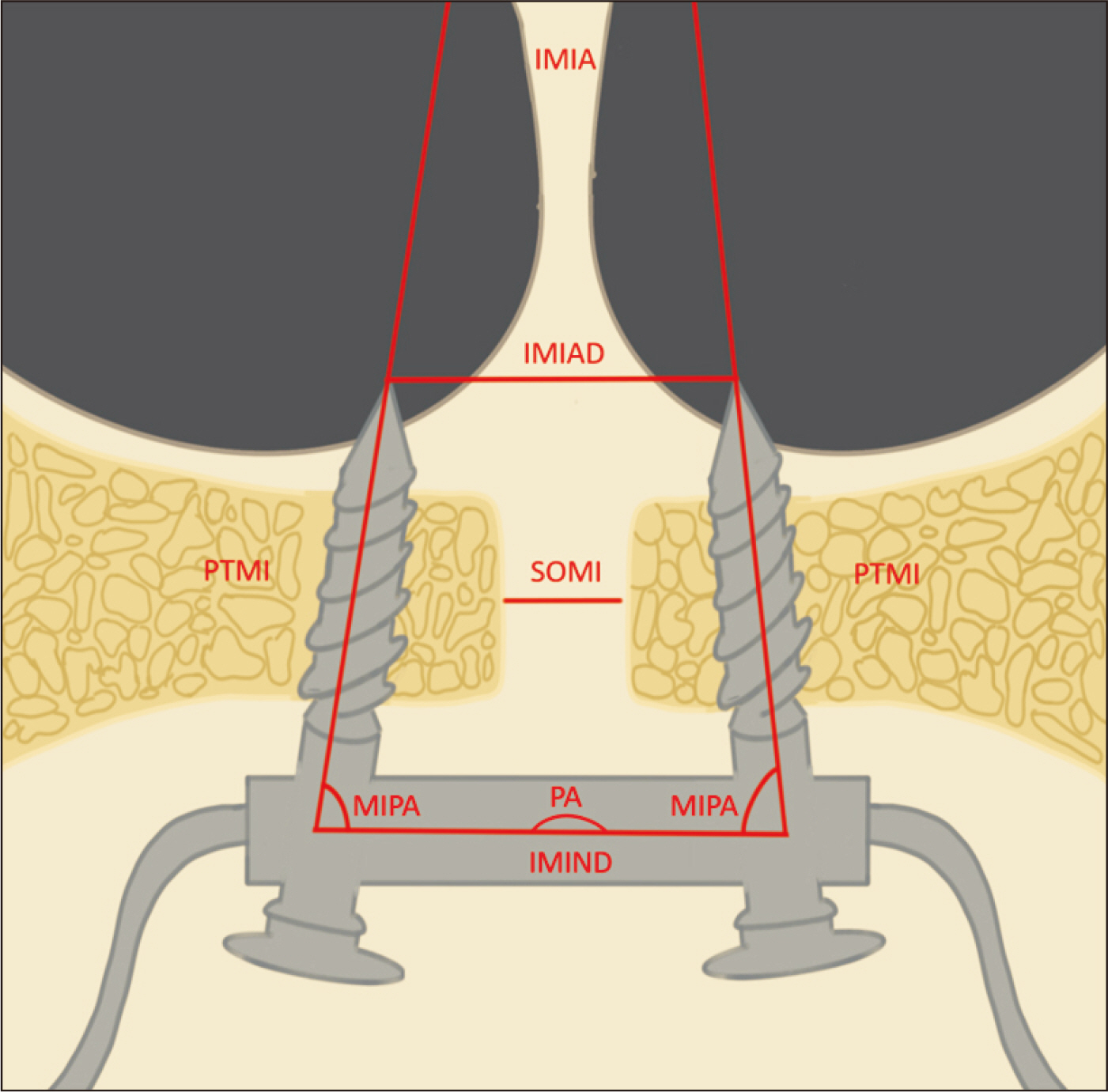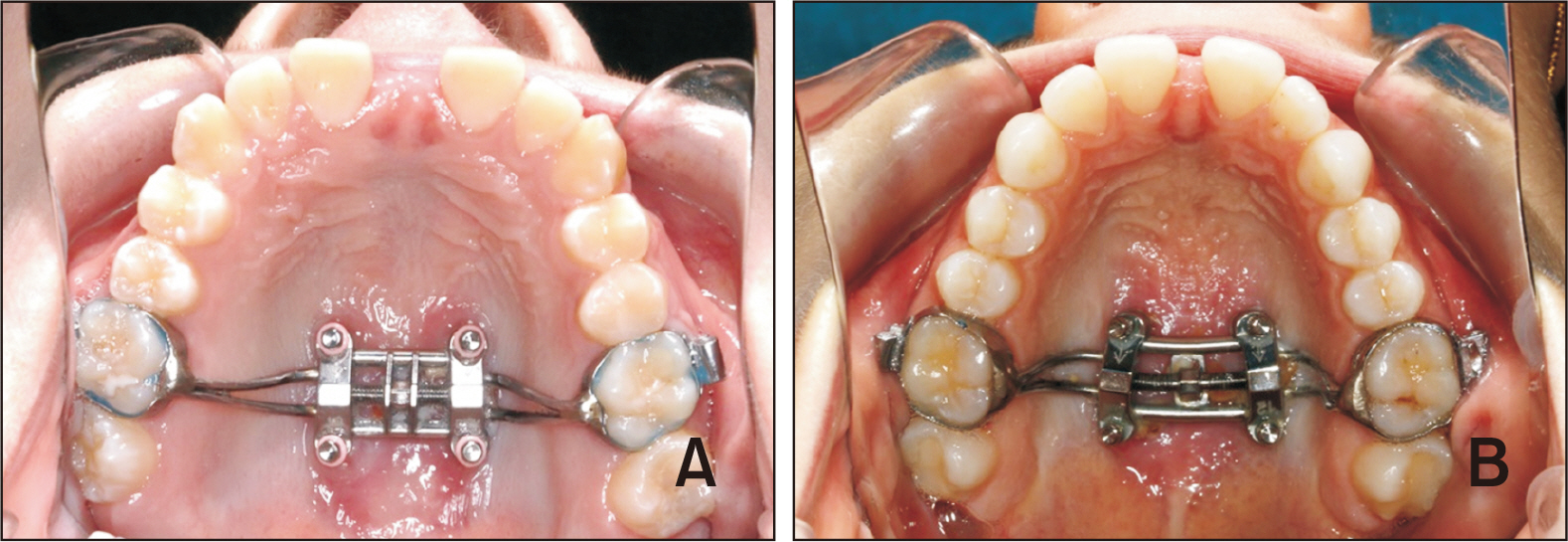Korean J Orthod.
2023 Sep;53(5):289-297. 10.4041/kjod23.056.
Pattern of microimplant displacement during maxillary skeletal expander treatment: A cone-beam computed tomography study
- Affiliations
-
- 1Private Practice, Houston, TX, USA
- 2Center for Health Science, Section of Orthodontics, UCLA School of Dentistry, Los Angeles, CA, USA
- 3Department of Orthodontics, Rey Juan Carlos University, Madrid, Spain
- 4Department of Orthodontics, State University of New York, Buffalo, NY, USA
- 5Section of Orthodontics, UCSF School of Dentistry, San Francisco, CA, USA
- 6Orthodontic and Craniofacial Development Research, Forsyth Institute, Cambridge, MA, USA
- 7Department of Orthodontics, Ajou University, School of Medicine, Suwon, Korea
- KMID: 2546549
- DOI: http://doi.org/10.4041/kjod23.056
Abstract
Objective
To analyze the microimplant (MI) displacement pattern on treatment with a maxillary skeletal expander (MSE) using cone-beam computed tomography (CBCT).
Methods
Thirty-nine participants (12 males and 27 females; mean age, 18.2 ± 4.2 years) were treated successfully with the MSE II appliance. Their pre- and post-expansion CBCT data were superimposed. The pre- and post-expansion anterior and posterior inter-MI angles, neck and apical inter-MI distance, plate angle, palatal bone thickness at the MI positions, and suture opening at the MI positions were measured and compared.
Results
The jackscrew plate was slightly bent in both anterior and posterior areas. There was no significant difference in the extent of suture opening between the anterior and posterior MIs (P > 0.05). The posterior MI to hemiplate line was greater than that anteriorly (P < 0.05). The apical distance between the posterior MIs was greater than that anteriorly (P < 0.05). The palatal thickness at the anterior MIs was significantly greater than that posteriorly (P > 0.01).
Conclusions
In the coronal plane, the angulation between the anterior MIs in relation to the jackscrew plate was greater than that between the posterior MIs owing to the differential palatal bone thickness.
Keyword
Figure
Cited by 1 articles
-
READER’S FORUM
Soo Hyun Nam
Korean J Orthod. 2025;55(1):1-2. doi: 10.4041/kjod55.0001RF.
Reference
-
References
1. Baccetti T, Franchi L, Cameron CG, McNamara JA Jr. 2001; Treatment timing for rapid maxillary expansion. Angle Orthod. 71:343–50. https://pubmed.ncbi.nlm.nih.gov/11605867/.2. Kiliç N, Kiki A, Oktay H. 2008; A comparison of dentoalveolar inclination treated by two palatal expanders. Eur J Orthod. 30:67–72. https://doi.org/10.1093/ejo/cjm099. DOI: 10.1093/ejo/cjm099. PMID: 18276928.
Article3. Olmez H, Akin E, Karaçay S. 2007; Multitomographic evaluation of the dental effects of two different rapid palatal expansion appliances. Eur J Orthod. 29:379–85. https://doi.org/10.1093/ejo/cjm034. DOI: 10.1093/ejo/cjm034. PMID: 17702798.
Article4. Kartalian A, Gohl E, Adamian M, Enciso R. 2010; Cone-beam computerized tomography evaluation of the maxillary dentoskeletal complex after rapid palatal expansion. Am J Orthod Dentofacial Orthop. 138:486–92. https://doi.org/10.1016/j.ajodo.2008.10.025. DOI: 10.1016/j.ajodo.2008.10.025. PMID: 20889055.
Article5. Lagravère MO, Carey J, Heo G, Toogood RW, Major PW. 2010; Transverse, vertical, and anteroposterior changes from bone-anchored maxillary expansion vs traditional rapid maxillary expansion: a randomized clinical trial. Am J Orthod Dentofacial Orthop. 137:304.e1–12. discussion 304–5. https://doi.org/10.1016/j.ajodo.2009.09.016. DOI: 10.1016/j.ajodo.2009.09.016. PMID: 20197161.
Article6. Carlson C, Sung J, McComb RW, Machado AW, Moon W. 2016; Microimplant-assisted rapid palatal expansion appliance to orthopedically correct transverse maxillary deficiency in an adult. Am J Orthod Dentofacial Orthop. 149:716–28. https://doi.org/10.1016/j.ajodo.2015.04.043. DOI: 10.1016/j.ajodo.2015.04.043. PMID: 27131254.
Article7. Seo YJ, Chung KR, Kim SH, Nelson G. 2015; Camouflage treatment of skeletal class III malocclusion with asymmetry using a bone-borne rapid maxillary expander. Angle Orthod. 85:322–34. https://doi.org/10.2319/031314-189.1. DOI: 10.2319/031314-189.1. PMID: 25032737. PMCID: PMC8631886.
Article8. Yılmaz A, Arman-Özçırpıcı A, Erken S, Polat-Özsoy Ö. 2015; Comparison of short-term effects of mini-implant-supported maxillary expansion appliance with two conventional expansion protocols. Eur J Orthod. 37:556–64. https://doi.org/10.1093/ejo/cju094. DOI: 10.1093/ejo/cju094. PMID: 25564504.
Article9. Romano FL, Sverzut CE, Trivellato AE, Saraiva MCP, Nguyen TT. 2022; Alveolar defects before and after surgically assisted rapid palatal expansion (SARPE): a CBCT assessment. Dental Press J Orthod. 27:e2219299. https://doi.org/10.1590/2177-6709.27.2.e2219299.oar. DOI: 10.1590/2177-6709.27.2.e2219299.oar. PMID: 35703612. PMCID: PMC9191858. PMID: 43d872e35c154a9b979915107a8c770f.
Article10. Holberg C, Winterhalder P, Rudzki-Janson I, Wichelhaus A. 2014; Finite element analysis of mono- and bicortical mini-implant stability. Eur J Orthod. 36:550–6. https://doi.org/10.1093/ejo/cjt023. DOI: 10.1093/ejo/cjt023. PMID: 23598610.
Article11. Lee RJ, Moon W, Hong C. 2017; Effects of monocortical and bicortical mini-implant anchorage on bone-borne palatal expansion using finite element analysis. Am J Orthod Dentofacial Orthop. 151:887–97. https://doi.org/10.1016/j.ajodo.2016.10.025. DOI: 10.1016/j.ajodo.2016.10.025. PMID: 28457266. PMCID: PMC5472094.
Article12. Paredes N, Colak O, Sfogliano L, Elkenawy I, Fijany L, Fraser A, et al. 2020; Differential assessment of skeletal, alveolar, and dental components induced by microimplant-supported midfacial skeletal expander (MSE), utilizing novel angular measurements from the fulcrum. Prog Orthod. 21:18. https://doi.org/10.1186/s40510-020-00320-w. DOI: 10.1186/s40510-020-00320-w. PMID: 32656601. PMCID: PMC7355053. PMID: 3f36d2bd852c4ec9aa3cacd7ca6825e4.
Article13. Colak O, Paredes NA, Elkenawy I, Torres M, Bui J, Jahangiri S, et al. 2020; Tomographic assessment of palatal suture opening pattern and pterygopalatine suture disarticulation in the axial plane after midfacial skeletal expansion. Prog Orthod. 21:21. https://doi.org/10.1186/s40510-020-00321-9. DOI: 10.1186/s40510-020-00321-9. PMID: 32686018. PMCID: PMC7370251. PMID: d48b855ae99f48ea93dcefe40cb63710.
Article14. Cantarella D, Dominguez-Mompell R, Moschik C, Mallya SM, Pan HC, Alkahtani MR, et al. 2018; Midfacial changes in the coronal plane induced by microimplant-supported skeletal expander, studied with cone-beam computed tomography images. Am J Orthod Dentofacial Orthop. 154:337–45. https://doi.org/10.1016/j.ajodo.2017.11.033. DOI: 10.1016/j.ajodo.2017.11.033. PMID: 30173836.
Article15. Han S, Bayome M, Lee J, Lee YJ, Song HH, Kook YA. 2012; Evaluation of palatal bone density in adults and adolescents for application of skeletal anchorage devices. Angle Orthod. 82:625–31. https://doi.org/10.2319/071311-445.1. DOI: 10.2319/071311-445.1. PMID: 22077190. PMCID: PMC8845559.
Article16. Wilmes B, Ludwig B, Vasudavan S, Nienkemper M, Drescher D. 2016; The T-Zone: median vs. paramedian insertion of palatal mini-implants. J Clin Orthod. 50:543–51. https://pubmed.ncbi.nlm.nih.gov/27809213/.17. Wang M, Sun Y, Yu Y, Ding X. 2017; Evaluation of palatal bone thickness for insertion of orthodontic mini-implants in adults and adolescents. J Craniofac Surg. 28:1468–71. https://doi.org/10.1097/SCS.0000000000003906. DOI: 10.1097/SCS.0000000000003906. PMID: 28841595.
Article18. Chatzigianni A, Keilig L, Reimann S, Eliades T, Bourauel C. 2011; Effect of mini-implant length and diameter on primary stability under loading with two force levels. Eur J Orthod. 33:381–7. https://doi.org/10.1093/ejo/cjq088. DOI: 10.1093/ejo/cjq088. PMID: 21062964.
Article19. MacGinnis M, Chu H, Youssef G, Wu KW, Machado AW, Moon W. 2014; The effects of micro-implant assisted rapid palatal expansion (MARPE) on the nasomaxillary complex--a finite element method (FEM) analysis. Prog Orthod. 15:52. https://doi.org/10.1186/s40510-014-0052-y. DOI: 10.1186/s40510-014-0052-y. PMID: 25242527. PMCID: PMC4148550.
Article20. Poorsattar-Bejeh Mir A. 2017; Monocortical versus bicortical hard palate anchorage with the same total available cortical thickness: a finite element study. J Investig Clin Dent. 8:e12218. https://doi.org/10.1111/jicd.12218. DOI: 10.1111/jicd.12218. PMID: 27157504.
Article21. Lombardo L, Carlucci A, Maino BG, Colonna A, Paoletto E, Siciliani G. 2018; Class III malocclusion and bilateral cross-bite in an adult patient treated with miniscrew-assisted rapid palatal expander and aligners. Angle Orthod. 88:649–64. https://doi.org/10.2319/111617-790.1. DOI: 10.2319/111617-790.1. PMID: 29714067. PMCID: PMC8183134.
Article22. Wilmes B, Nienkemper M, Drescher D. 2010; Application and effectiveness of a mini-implant- and tooth-borne rapid palatal expansion device: the hybrid hyrax. World J Orthod. 11:323–30. https://pubmed.ncbi.nlm.nih.gov/21490997/.23. Pithon MM, Figueiredo DS, Oliveira DD. 2013; Mechanical evaluation of orthodontic mini-implants of different lengths. J Oral Maxillofac Surg. 71:479–86. https://doi.org/10.1016/j.joms.2012.10.002. DOI: 10.1016/j.joms.2012.10.002. PMID: 23273488.
Article24. Brunetto DP, Sant'Anna EF, Machado AW, Moon W. 2017; Non-surgical treatment of transverse deficiency in adults using microimplant-assisted rapid palatal expansion (MARPE). Dental Press J Orthod. 22:110–25. https://doi.org/10.1590/2177-6709.22.1.110-125.sar. DOI: 10.1590/2177-6709.22.1.110-125.sar. PMID: 28444019. PMCID: PMC5398849.
Article25. Cantarella D, Dominguez-Mompell R, Mallya SM, Moschik C, Pan HC, Miller J, et al. 2017; Changes in the midpalatal and pterygopalatine sutures induced by micro-implant-supported skeletal expander, analyzed with a novel 3D method based on CBCT imaging. Prog Orthod. 18:34. https://doi.org/10.1186/s40510-017-0188-7. DOI: 10.1186/s40510-017-0188-7. PMID: 29090368. PMCID: PMC5663987. PMID: c0a5028c7c5749d28981e5b6114032c6.
Article26. Brettin BT, Grosland NM, Qian F, Southard KA, Stuntz TD, Morgan TA, et al. 2008; Bicortical vs monocortical orthodontic skeletal anchorage. Am J Orthod Dentofacial Orthop. 134:625–35. https://doi.org/10.1016/j.ajodo.2007.01.031. DOI: 10.1016/j.ajodo.2007.01.031. PMID: 18984394.
Article
- Full Text Links
- Actions
-
Cited
- CITED
-
- Close
- Share
- Similar articles
-
- Effect of bone-borne maxillary skeletal expanders on cranial and circummaxillary sutures: A cone-beam computed tomography study
- Skeletal and dentoalveolar effects of different types of microimplant-assisted rapid palatal expansion
- Detection of maxillary second molar with two palatal roots using cone beam computed tomography: a case report
- A rare case of dilated invaginated odontome with talon cusp in a permanent maxillary central incisor diagnosed by cone beam computed tomography
- Comparison of panoramic radiography and cone beam computed tomography for assessing the relationship between the maxillary sinus floor and maxillary molars

